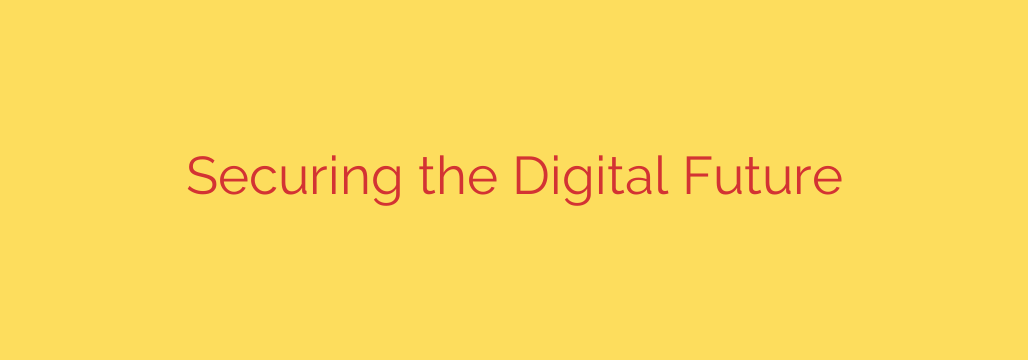
Cybersecurity in the Digital Age: Your Guide to a Secure Future
In today’s interconnected world, our lives are increasingly lived online. From banking and shopping to professional networking and personal communication, our digital footprint is larger than ever before. While this brings incredible convenience, it also exposes us to a new and evolving set of risks. Understanding and implementing strong cybersecurity practices is no longer an option—it’s an essential skill for navigating modern life.
The landscape of cyber threats is constantly changing. Attackers are using more sophisticated tools and psychological tactics to target not just large corporations, but individuals and small businesses. Taking proactive steps to secure your digital presence is the most effective way to protect your data, finances, and identity.
The Evolving Threat Landscape
To build a strong defense, you must first understand what you’re up against. While the methods are always advancing, most cyber threats fall into a few key categories:
- Phishing: These are fraudulent attempts, usually made through email, to trick you into revealing sensitive information like passwords or credit card numbers. These messages often create a sense of urgency or mimic legitimate communications from banks, tech companies, or even your colleagues.
- Malware: Short for “malicious software,” this is a broad term for any software designed to harm or disrupt your computer. This includes viruses, spyware that secretly gathers your information, and adware that bombards you with unwanted ads.
- Ransomware: A particularly nasty form of malware, ransomware encrypts your files, making them completely inaccessible. The attackers then demand a ransom payment, often in cryptocurrency, in exchange for the decryption key.
Foundational Pillars of Your Digital Defense
You don’t need to be a technology expert to dramatically improve your online security. The most powerful defenses are often the simplest ones, practiced consistently. Start with these non-negotiable fundamentals.
1. Master Your Passwords
Weak and reused passwords are one of the most common entry points for attackers. A strong password is long, complex, and unique to each account.
- Action Tip: Avoid common words, birthdays, or “Password123.” Instead, create a passphrase—a sequence of random words like “Blue-Guitar-Mountain-Stapler”—that is easy for you to remember but nearly impossible for a computer to guess. Better yet, use a reputable password manager to generate and store highly complex, unique passwords for every single one of your accounts.
2. Enable Multi-Factor Authentication (MFA)
This is arguably the single most effective step you can take to secure your accounts. MFA adds a second layer of security beyond just your password, requiring you to verify your identity through another method. This is typically a code sent to your phone, a tap on an authenticator app, or a biometric scan like your fingerprint.
- Action Tip: Enable MFA on every account that offers it, especially for critical services like your email, banking, and social media. Even if a criminal steals your password, they won’t be able to access your account without that second factor.
3. Keep Your Software Updated
Those persistent notifications to update your phone, computer, and applications are not just about adding new features. More often than not, these updates contain critical security patches that fix vulnerabilities discovered by developers.
- Action Tip: Do not ignore software updates. Enable automatic updates whenever possible. Running outdated software is like leaving a window open for cybercriminals to climb through.
Advanced Strategies for Proactive Security
Once you’ve locked down the basics, you can adopt more advanced habits to further reduce your risk profile.
Be Skeptical of Unsolicited Communication: Always approach unexpected emails, texts, or direct messages with caution. Think before you click. Hover over links to see the actual destination URL before clicking. If an email from your bank seems suspicious, don’t click its links; instead, go directly to the bank’s website by typing the address yourself or using a trusted bookmark.
Understand Your Digital Footprint: Be mindful of the information you share online. Every piece of data you post on social media or submit on a website can potentially be collected and used by others. Regularly review the privacy settings on your accounts to control who can see your information.
Implement a Backup Strategy: In the event of a ransomware attack or a critical hardware failure, having a reliable backup of your important files is your ultimate safety net. Follow the 3-2-1 rule: keep at least three copies of your data, on two different types of media, with one copy stored off-site (e.g., in the cloud or on an external drive at a different location).
Securing the Connected Future: The Internet of Things (IoT)
Our homes are becoming smarter, filled with internet-connected devices like smart speakers, security cameras, thermostats, and even refrigerators. While convenient, each of these “Internet of Things” (IoT) devices is a potential entry point into your home network if not properly secured.
- Action Tip: When setting up a new smart device, your first step should always be to change the default username and password. Many manufacturers use simple, publicly known defaults (like “admin” and “password”) that make them easy targets. Keep their firmware updated just as you would with your computer or phone.
Ultimately, securing your digital future is an ongoing process, not a one-time task. By building a foundation of strong security habits and staying informed about new threats, you can navigate the digital world with confidence and peace of mind. Your security is in your hands.
Source: https://www.paloaltonetworks.com/blog/2025/08/forging-secure-digital-future/








